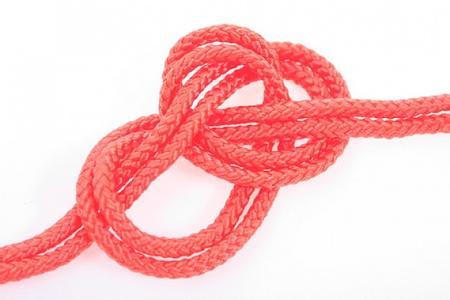(单词翻译:单击)
听力文本
This is Scientific American — 60-Second Science. I'm Christopher Intagliata.
Of the many puzzles mathematicians ponder, one is new ways to tie knots. "There are more than six billion different types of knots that have been tabulated by mathematicians. Six billion." David Leigh, a chemist at the University of Manchester in the U.K.
The hard part, he says, is actually making them. "Just because I can see a knitted jumper doesn't mean I can actually make one." Because what Leigh and his colleagues are interested in, is tying molecular knots—using strands that are 10,000 times thinner than a human hair.
"With a molecule you can't just grab hold of the ends and tie them like you would a shoelace. They're too small for that. Instead you've got to use chemistry to make the molecules fold themselves round into the precise way you need to form the particular knot."
Continuing the shoelace analogy—remember when you were learning to tie your shoes, your mom or dad put a finger in the middle of the knot, to make it easier to tie? Leigh and his team did something similar, but used metal ions as the "fingers" to keep the knot tying organized. Then tiny molecular strands, just 192 atoms long, assembled themselves around the ions.

"And then mum pulls her finger out—we extract the metal ions out—and you're left with just the knot at the end." The most complex molecular knot ever synthesized. The study is in the journal Science.
Knots were hugely useful to our ancestors in the stone age: "fishing nets, axes with blades tied to the handles, how to weave fabrics to keep him warm." And Leigh says knots could be just as helpful in the molecular world—like for stronger braided polymers—maybe a better Kevlar.
After all, we do have six billion knots to choose from. "As every Boy Scout knows, different types of knots have different characteristics that make them more or less suited to particular tasks." And yes, Leigh himself was once a Scout. "I found knots difficult to tie then, and it hasn't gotten easier as I've gotten older."
Thanks for listening for Scientific American — 60-Second Science Science. I'm Christopher Intagliata.
参考译文
这里是科学美国人——60秒科学。我是克里斯托弗·因塔利亚塔。
数学家思考的谜题有很多,其中一个就是打结的新方法。“数学家已经想出了超过60亿种不同的打结方法。”大卫·利是英国曼彻斯特大学的化学家。
他表示,困难之处在于打结的过程。“我能看到针织毛衣并不意味着我可以织一件毛衣。”利和他同事感兴趣的是打“分子”结,即用比人类头发细1万倍的线来打结。
“你不能像绑鞋带一样抓住分子的两端来打结。因为它们太小了。你要让分子自己折叠,以精确地方式按你所需要的进行打结。”
继续鞋带的类比分析,还记得你学习系鞋带的时候,你的妈妈或者爸爸会把手指放到结的中间,以使打结更容易吗?利和他的团队做了类似的事情,不过他们用金属离子代替“手指”来打结。然后,只有192原子长的小分子链围绕金属离子聚集起来。
“然后妈妈抽出手指,而我们提取出金属离子,最后只剩下打得结。” 这是人工合成的最复杂的分子结。该研究结果发表在《科学》期刊上。
在石器时代,对我们的祖先来说打结非常有用:“渔网、有把手的斧头以及通过编织物保暖。”利表示,结在分子世界也一样非常有用,比如更坚韧的辫状聚合物,或是更好的凯夫拉尔纤维。
但是毕竟我们有60亿种结可以选择。“童子军知道,不同的结有不同的特征,适合于特定的任务。”利自己也曾经是一名童子军。“当时我认为打结非常难,我长大了以后也没觉得打结简单。”
谢谢大家收听科学美国人——60秒科学。我是克里斯托弗·因塔利亚塔。
译文为可可英语翻译,未经授权请勿转载!
重点讲解
重点讲解:
1. be interested in 感兴趣的;有兴趣的;关心的;
例句:The little girl is very interested in the old legend of immortal creatures.
小女孩对有关永生的精灵的古老传奇非常感兴趣。
2. in the middle of 正忙于;
例句:It's a bit hectic. I'm in the middle of cooking for nine people.
我正忙着为9个人做饭呢,有点儿忙不过来。
3. after all 毕竟;终究;
例句:Our view are not so far apart, after all.
我们的见解毕竟没有多大的分歧。
4. more or less 或多或少;大概;几乎;
例句:His explanation was more or less helpful.
他的解释多少有些帮助。


